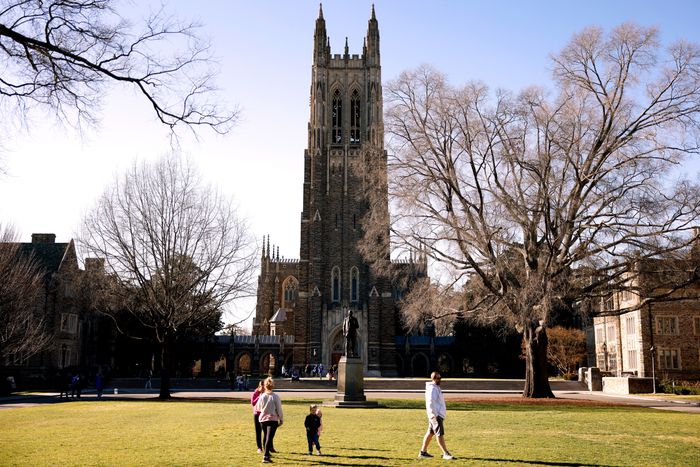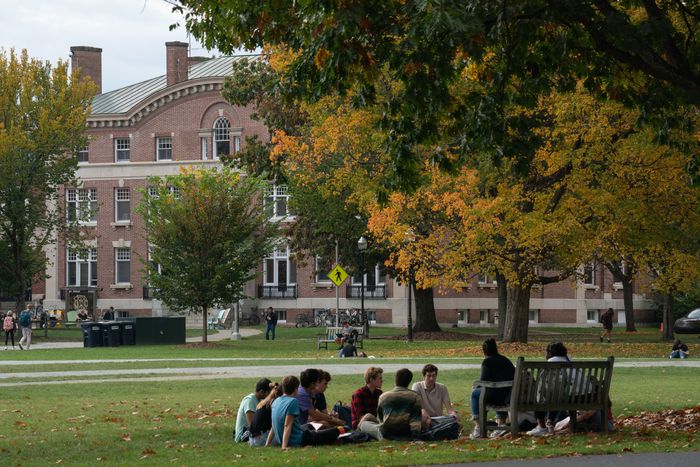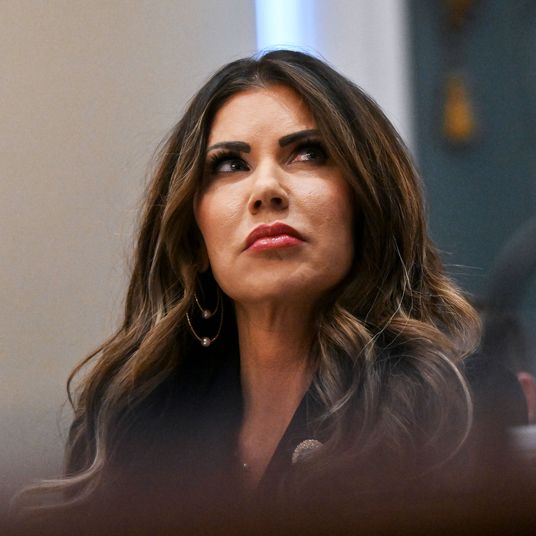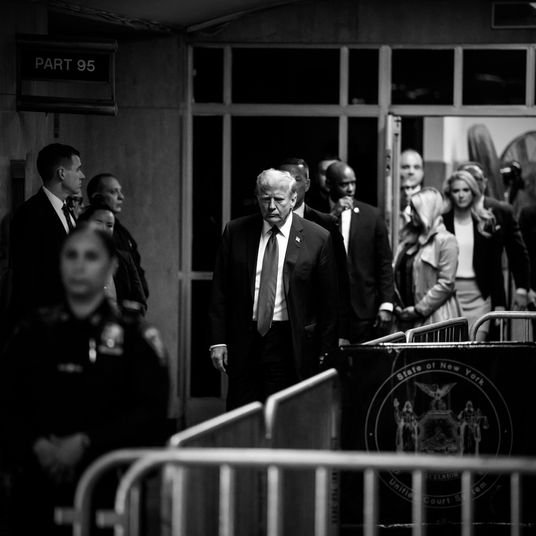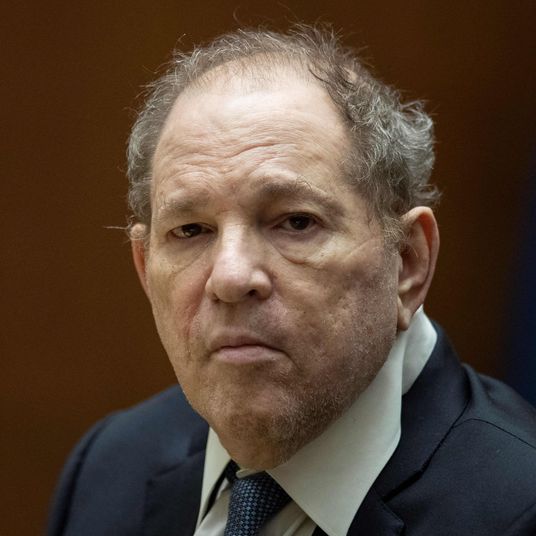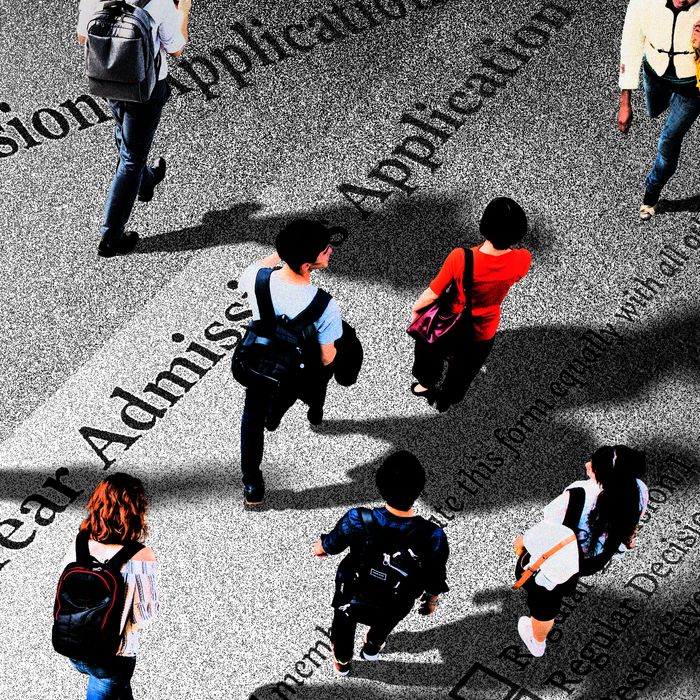
This article was featured in One Great Story, New York’s reading recommendation newsletter. Sign up here to get it nightly.
Nearly every weekday morning during the winter months, Christoph Guttentag blocks off four hours on his schedule for reading. The task: helping to sort through the 48,000 applications that have arrived for regular-decision admission to Duke University. Even the veteran dean of admissions at Duke, in his job since 1992 and leading a staff of 40, is not exempt. “Ten before ten” is his goal each morning. During his tenure, applications to Duke have basically quadrupled; in the last five years, they are up 37 percent. Everyone has a lot more applications to review, including the boss.
As Guttentag opens a student’s file on his computer, he scans an overview page that shows high school attended, grade-point average, standardized test scores (if they submitted them), intended major, and gender. In the past this sheet would have included an applicant’s race, allowing the school to track how it was doing in selecting students from underrepresented groups. Following a Supreme Court decision last year banning racially preferential admissions, that data point is now hidden.
Guttentag then pulls up the applicant’s full high-school transcript. A few minutes later, he moves on to the teacher and counselor recommendations, the essays, and the extracurricular activities. As he takes notes, he isn’t tallying up points, he told me. “It all floats around in the air above me,” he said. “I keep on holding all this information in abeyance. I hope that as I read the application from beginning to end, it coalesces into an image of the child.”
Within 15 minutes, sometimes less, he hopes to have formed a clear enough image to decide if this is a competitive applicant and can be moved on to another admissions officer for a detailed evaluation — and eventually a larger committee where most final decisions are made. These days fewer than half of applicants to Duke go through that full evaluation process. The ultimate destiny of many applicants — accept, deny, waitlist — are determined in these initial readings. As with every stage in the college-admissions process, each year the math has been getting harsher here. In late March, when this round of decisions is released, Duke will say no to almost everyone — some 95 percent of applicants. To get there, Guttentag knows that “roughly, I have to say no to about two-thirds to three-fourths” in this early pass.
College admissions has always been filled with uncertainty, especially at schools like Duke where applications are plentiful and seats scarce. But when Guttentag started as dean three decades ago, the process was more forgiving: Duke accepted some 28 percent of applicants, and about 41 percent of them attended — the university’s yield rate. Since the turn of this century, the number of applications to the 67 most selective colleges in the nation, which includes Duke, has tripled — to nearly 2 million a year. That has translated into more stress and longer odds for a lot of applicants, and a much more complicated set of considerations for colleges, in terms of who to admit and when to admit them.
Yield rates — a truer gauge of popularity than acceptance rates when students have multiple options — have plummeted at all but the most selective schools. For colleges and universities, yield is an institutional status symbol, but it is also a important signal of financial strength. Duke’s yield rate is now 60 percent — nearly 50 percent higher than it was when Gettentag started here. Many schools that had similar yield rates to Duke three decades ago have seen theirs go in the opposite direction, including Brandeis University (now 25 percent), George Washington University (19 percent), and Syracuse University (16 percent).
As this year’s college-admissions season nears its close, with decisions arriving from schools this month, it is already shaping up as the craziest ever. Applications to the 1,000-plus colleges that are part of the Common Application are up 6 percent over last year’s total, which was already a record. It’s a continuation of a dynamic that began in the spring of 2020, when the pandemic forced hundreds of top-ranked colleges to drop their requirements for standardized-test scores and generated a surge of applications as a result.
As students spray more applications into the system, colleges are spending more and more time thinking about how to forecast who will actually show up if accepted — and shaping their policies to lock in those students and maintain or increase their yield rates. They have rolled out a complicated menu of admissions options, each with its own requirements, deadlines, restrictions, and risks for students — but all designed to bring as much certainty to the college as possible.
Admissions policies instituted by schools at or near the top of the rankings have ripple effects at less-selective schools downstream, which, in turn, make changes to protect their yield rates. For example, less-selective schools have embraced a strategy of increasingly deferring applicants in early rounds to see if they’re serious — or even denying them outright when the school thinks it’s being used as a backup.
Figuring out how to navigate this all can leave applicants and their families feeling like they need a Ph.D. in game theory just to get into college. Talk with American high-school seniors who plan on an undergraduate education and you’ll find a consistent range of emotions: anxiety, confusion, shock. College presidents say they’re worried about student mental health on campuses, but they’ve also been responsible for policies that make the application process more stressful and confusing than it has ever been before. Yes, both colleges and applicants are players in this game, but schools often seem to be playing offense while students are left to flounder on defense.
Every selective college practices what it calls “holistic review,” which allows them to consider a variety of factors beyond grades and test scores when admitting students. No two colleges follow the exact same routine for evaluating applicants, however, and no one can adequately explain how the system really works without making an acceptance sound like a winning lottery ticket.
The process is also now more opaque than ever. Six years ago, I approached 24 selective colleges to let me embed myself in their admissions process for a book I was writing. Only three said yes: Davidson College, Emory University, and the University of Washington. Last fall, I asked a dozen colleges if I could observe their process in light of the changes to admissions in recent years. They all said no, fearing an outside observer in the first year they were also trying to navigate the aftermath of the Supreme Court decision.
With the rules of the game being cryptic, applicants try to decipher the opponent’s playbook as best they can. Reddit threads, College Confidential, and TikTok videos are full of advice about what admissions officers supposedly want. So colleges respond by becoming even more guarded in what they share. Even then, information can be misinterpreted. Several years ago when the University of Pennsylvania announced its admitted class, it included a list of their attributes — among them that one-third of accepted students worked on research projects in high school. As Whitney Soule, Penn’s dean of admissions, told the story at a panel discussion I moderated last September, within months that one-third figure became “amended” and “monetized” in some places to “Penn requires research.”
Nothing is as ambiguous right now as how grades, courses, and test scores are used by colleges in the admissions process. When Guttentag at Duke reviews applications, he orders them by high school so that he understands the curriculum available to a particular group of students. The majority of applicants have competitive transcripts, he said, but one consequence of the huge increase in applications is that far fewer of them “knock your socks off.”
A decade ago, admissions officers at Duke regularly talked about a “wall of 5s” among applicants on Advanced Placement tests — the top score. “You’d just see this long list of eight or ten or 12 5s on AP scores,” Guttentag recalled. “That’s the sort of thing that would by itself have moved the needle and now doesn’t.” Only 14 percent of the 4.39 million AP tests administered last year were scored a 5, according to the College Board; only half of American public high schools even offer more than five AP courses. Yet the fact that they were so commonplace among Duke’s applicant pool didn’t seem to shock him.
Duke, like most top-ranked colleges, remains test-optional, giving applicants the choice whether to submit SAT or ACT scores. Over the last month, Dartmouth, Yale, and Brown broke with their Ivy League peers and followed the Massachusetts Institute of Technology as the most selective schools so far to require test scores once again. Most highly selective schools have already announced another year of test-optional policies, leaving a whole new set of seniors to try and guess if test-optional is really test-optional.
The irony of college admissions is that the decision whether to admit someone is based on the future, not the past. It ultimately hinges on the judgment of an admissions officer about the potential of that teenager over the next four years. The outrage now common when admissions decisions are handed down is because parents and students have used uniformly understood stats — mostly GPAs and test scores of previous applicants from a high school — to determine their list of reach, target, and safety schools.
But admissions offices don’t look at those easy markers of merit the way parents and students do. It’s like the two sides are speaking different languages. “You don’t have to have the maximum level of preparation to potentially do the work,” Guttentag told me. He compared admissions to how an NBA franchise might draft players from college teams that don’t play in the power conferences. “They haven’t played in that context, they haven’t shown success in that context, but they have the potential to be successful at the next level. Pro teams don’t always get it right. Colleges don’t always get it right.”
Although colleges promote their early admissions options as insurance cards that both sides can play in the game, the spoils largely go to the schools. They have convinced a generation of students to truncate their college search by submitting applications before November of their senior year. Students see early decision as a trick to help them get into a super-selective school, while early action is a strategy for seniors to sit on a decision while they bombard a dozen other schools with applications to see where they can get in and compare financial-aid offers. This past fall, the number of applications filed for early decision (a binding commitment if students get accepted) and early action (which is not binding) continued to inch closer to those sent in January for regular decision, according to the Common Application. In just the last five years, the number of early applications jumped by 1 million, a 60 percent increase, while the number filed for regular decision increased by 26 percent.
Among the effects of this change is that applying to less-selective schools — including back-up options — has become less straightforward. “I find it very challenging to come up with target and safety schools for students anymore,” Weeze Cullen, a college and career specialist at Winter Park High School near Orlando told me. Already this year, Florida State University, long considered a safety school for the average Winter Park senior, saw a 28 percent increase in early action applications; one-third of those applicants weren’t given any decision at all and instead deferred to the regular round this spring.
Florida State’s new practices can be read as an effect of elite colleges changing how and when they admit students. The top schools really shape the larger game: They make the rules and their priorities — whether that means they want more economic diversity or families that can pay full freight or more female engineering majors from the Great Plains — define the outcomes for other players.
In the wake of last year’s Supreme Court decision holding that race-conscious admissions discriminated against Asian Americans, assembling as large of a pool of applicants as possible up front has become even more important for colleges as they seek to enroll a diverse class. In one closely watched number, applicants identifying on the Common App as an underrepresented minority have increased by 10 percent — a box that students still check but that is now hidden from schools as they evaluate applications. Applications to the most selective colleges — defined as those that accept fewer than 25 percent of students — from seniors who identify as Black are up 3.4 percent compared to last year, according to the Common App. Hispanic applicant numbers are up even higher at top-ranked schools, some 4.9 percent.
Applications to those colleges from students identifying as white dropped 5.8 percent over last year, while numbers for Asian Americans remained flat. Meanwhile, “unknown,” where applicants don’t list their race/ethnicity, grew 37 percent at the most selective schools.
This year, in the absence of being told an applicant’s race and ethnicity, many selective colleges are employing a tool from the College Board called Landscape. It provides key data points about an applicant’s school and neighborhood, including average SAT scores, percentage of students eligible for free and reduced lunch, crime, and median family income, among other factors. What’s more, schools continue to consider student demographics when building their pool of applicants, both up front and at the end of the process, during what’s known as “yield season” in April, when they host events and other activities to persuade students to enroll.
The more applications they have, the easier it is for schools to meet their diversity goals, admissions deans told me. That’s why any effort to curtail application growth or the tactics colleges use to manage yield is met with resistance by colleges. One oft-repeated idea is to lower the cap on the number of applications a single student can file through the Common Application (now 20). The Common App has 1,100 institutions as members and it’s frequently blamed for the ballooning application totals. And for good reason: Rutgers University, for example, saw its application numbers grow by 60 percent in its first year on the Common App to more than 63,000. (Common App’s chief executive, Jenny Rickard, rejects that idea: 90 percent of Common App schools offer another way to apply, she said, “so students will just go to one of those other applications” if the limit were lowered.)
All this reveals that the ultimate win in the game of admissions is less about the applicant and their needs, and much more about a college protecting its prestige (or better yet, improving its standing) as well as its bottom line in filling a class that meets certain enrollment and revenue goals. So, for now, we’re stuck with this system until one set of players in the game decides to make a different move or an external force orders a change to the rules.


